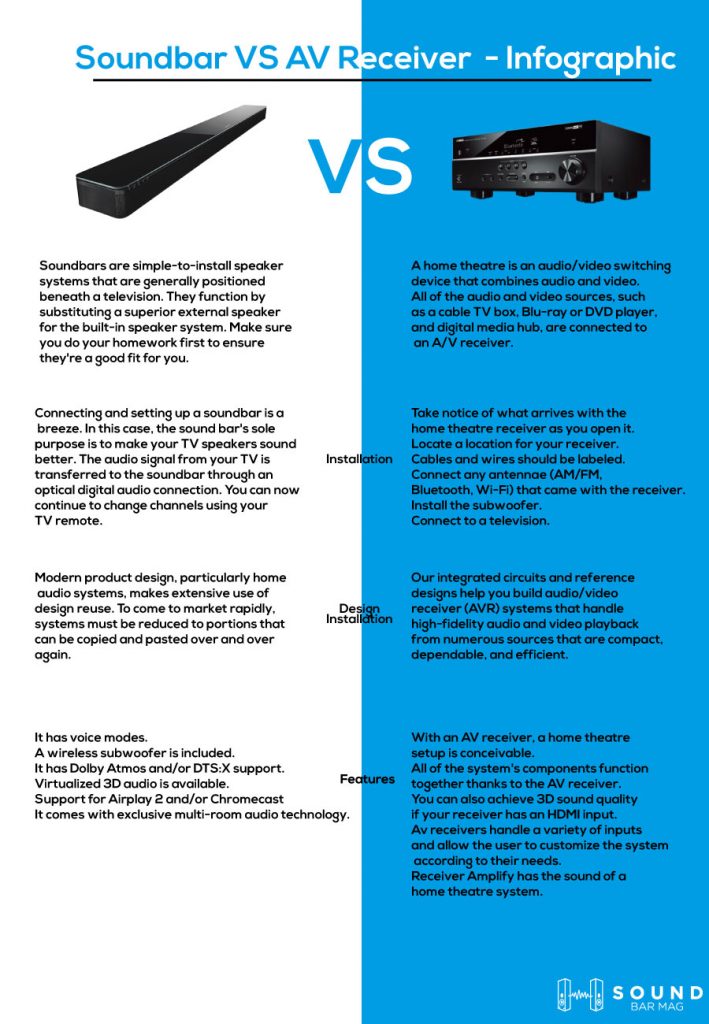We’ve never had it so nice when it comes to home media. There’s an endless amount of fantastic entertainment to enjoy from the comfort of your couch, from cassettes to streaming, TV episodes to movies.
It’s being provided in better-than-ever sound and video quality, and seeing and hearing it in all its splendor is surprisingly sensible thanks to a premium manufacturer.
By this topic, we can discuss in detail about installation, design, and features of both soundbar and AV receiver.
What is Soundbar?
Soundbars are simple-to-install speaker systems that are generally positioned beneath a television. They function by substituting a superior external speaker for the built-in speaker system. Make sure you do your homework first to ensure they’re a good fit for you.
Soundbars are simple to install speaker systems that are generally positioned beneath a television. They function by substituting a superior external speaker for the TV’s built-in speaker system. Make sure you do your homework first to ensure they’re a good fit for you.
What is an AV Receiver?
A home theatre is an audio/video switching device that combines audio and video. All of the audio and video sources, such as a cable TV box, Blu-ray or DVD player, and digital media hub, are connected to an A/V receiver. The receiver’s video output connects to the TV via HDMI, while its audio outputs use stranded cables to connect to speakers and a subwoofer. HDMI and speaker wires are examples.
Consider your typical home theatre. It could come with a DVD player, Blu-Ray player, or speakers. It will, of course, have a television. Any of these devices can be connected to an AVR, which will receive various signals. The AVR then synchronizes these signals and transmits them to the appropriate outputs.
Soundbar installation
There are numerous options for connecting soundbars to our televisions, Blu-ray players, and HDMI ports.
Scenario 1:
Connecting and setting up a soundbar is a breeze. In this case, the sound bar’s sole purpose is to make your TV speakers sound better. The audio signal from your TV is transferred to the soundbar through an optical digital audio connection. You can now continue to change channels using your TV remote.
Scenario 2:
The installation will take a little longer if you choose to connect your components to your soundbar. The HDMI soundbar connections ensure that Blu-ray soundtracks and other multi-channel formats sound their finest.
If your TV and soundbar both feature an HDMI ARC port, all you’ll need is a single HDMI cable. You’ll need both optical and HDMI connections between the TV and the soundbar if your TV doesn’t have an HDMI/ARC port. Your TV may require ARC activation.
AV Receiver installation
Installation for AV receivers is quite simple.
- Take notice of what arrives with the home theatre receiver as you open it.
- Locate a location for your receiver.
- Cables and wires should be labeled.
- Connect any antennae (AM/FM, Bluetooth, Wi-Fi) that came with the receiver.
- Install the subwoofer.
- Connect to a television.
Soundbar Design
Modern product design, particularly home audio systems, makes extensive use of design reuse. To come to market rapidly, systems must be reduced to portions that can be copied and pasted over and over again.
In a system with numerous inputs on one side of the unit and multiple inputs on the other, keeping the analog-to-digital converters (ADCs) and digital-to-analog converters (DACs) separate may make more sense.
Now we’re starting to think about design reuse and how to apply it to circuits with radically different forms.
AV Receiver Design
Our integrated circuits and reference designs help you build audio/video receiver (AVR) systems that handle high-fidelity audio and video playback from numerous sources that are compact, dependable, and efficient.
Traditional AVRs can now become multi-room media hubs because of advancements in wireless technologies and audio over internet protocol.
Soundbar Features
- It has voice modes.
- A wireless subwoofer is included.
- It has Dolby Atmos and/or DTS:X support.
- Virtualized 3D audio is available.
- Support for Airplay 2 and/or Chromecast
- It comes with exclusive multi-room audio technology.
AV Receiver Features
- With an AV receiver, a home theatre setup is conceivable.
- All of the system’s components function together thanks to the AV receiver.
- You can also achieve 3D sound quality if your receiver has an HDMI input.
- Av receivers handle a variety of inputs and allow the user to customize the system according to their needs.
- Receiver Amplify has the sound of a home theatre system.

Conclusion
IF you want compact convenience or no-holds-barred surround sound thrills, you can go with the soundbar or AV receiver to fit the bill.
You can get class-leading pictures and sound performances with both the soundbar and AV receiver in front of your couch. The soundbar option sounds good.

Mia Evelyn is a soundbar specialist and she love to test and review different soundbar brands. She shares her neutral and in-depth reviews through the Soundbar Mag.